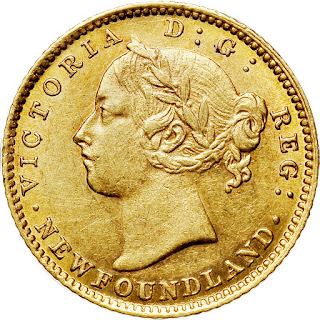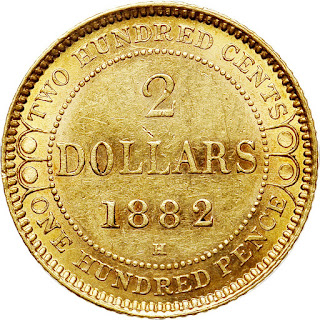Canada Newfoundland 2 Dollar Gold Coin 1882 Queen Victoria
Newfoundland's two-dollar gold piece was coined from 1865 to 1888.
Obverse: Laureated head of Queen Victoria, Queen of Newfoundland.
Lettering: VICTORIA D:G: REG: "VICTORIA DEI GRATIA REGINA." NEWFOUNDLAND
Engraver: Leonard Charles Wyon
Reverse: " 2 DOLLARS," and the date of the year of issue, surrounded by a dotted circle. Legend: "TWO HUNDRED CENTS." and "ONE HUNDRED PENCE."
This coin is very unusual in that it has the denomination expressed three different ways: TWO HUNDRED CENTS, TWO DOLLARS and ONE HUNDRED PENCE. The latter refers to its value in sterling.
Designer Leonard Charles Wyon.
Value: 2 Newfoundland dollar
Weight: 3.33 g
Diameter: 17.98 mm
Edge: Reeded
Composition: 91.7% Au, 8.3% Cu
Newfoundland struck $2 Dollars gold coins in 1865, 1870, 1882, 1880, 1882, 1882, 1885 and 1888. All are 17.98 mm and 3.33 grams of 91.7% gold and 8.3% copper (22 K gold) and have a coinage die axis. All years except for 1882 were struck at the Royal mint in London with 1882 being struck at the Ralph Heaton mint (with the H mint mark).
Newfoundland: Gold Two Dollars
The Newfoundland 2 dollar coin was issued in intermittent years between 1865 and 1888. It was the only circulation gold coin issued by a British colony. Although few coins were issued, it was broadly used in Newfoundland and Eastern Canada. The coin became scarce in 1894 because of hoarding following the collapse of Newfoundland's banks and monetary system.
Prior to Canadian confederation in 1867, provinces and colonies had separate currencies. Having been a colony from its founding until 1907, and then a dominion prior to joining Canada, Newfoundland had its own currency, the Newfoundland dollar, until 1949. Newfoundland began to issue its own decimal currency in 1865. The original plans for the new Newfoundland coinage suggested including a gold dollar similar to that of the United States. Over concerns that it would be easily lost as a result of its small size and value, the denomination of the gold coin was increased to 2 dollars.
Description
The resulting two-dollar coin had a diameter of 17.98 mm, the same as the ten cent coin — in comparison, a modern Canadian dime has a diameter of 18.03 mm. The obverse design had Queen Victoria. There was one principal portrait of Victoria, but a different one was used in 1865 and 1870, and a third one was used in 1882 and 1888. The reverse was notable in that three equivalent denominations were indicated: 2 dollars, 200 cents, and 100 pence. The third value was the equivalent in sterling.
History
Issued in various years between 1865 and 1888, few two-dollar coins were struck. The highest annual mintage was 25,000 in 1882 and 1888, while coins struck in 1880 are particularly rare because of a mintage of only 2,500. With the exception of the 1882 issue, struck at the Heaton Mint and bearing the mint mark "H", all of the coins were minted in London.
Newfoundland's 2 dollar coin was broadly used not only in Newfoundland but in Eastern Canada in general. The supply of the coins "virtually disappeared" in 1894, when Newfoundland's banks and monetary system collapsed. With paper banknotes being distrusted, the gold coins were hoarded, as well as two next highest Newfoundland denominations, the silver 50-cent and 20-cent pieces.
Significance
With its two-dollar coin, Newfoundland became the only British colony to issue circulating gold coinage apart from Sydney Mint which issued Australian sovereigns from 1855 onwards. Gold coinage was used in Canada and other British domains. For example, in the late 18th and early 19th centuries, common gold coins included coins from Portugal, British guineas or sovereigns, French louis d'or, American eagles, Spanish doubloons, and coins related to the eagles or doubloons. Canada issued circulation five-dollar and ten-dollar gold coins between 1912 and 1914, which were discontinued because of World War I. At the time, Canada was a Dominion. Newfoundland's 2 dollar coin is remarkable in that was issued by the colony itself, not having yet gained independence. While other contemporary British colonies (e.g. the British Raj) had gold coinage, Newfoundland was under responsible government; in the context of Canada, that resulted in Newfoundland being a self-governing colony, free to make its own decisions on internal matters, such as coinage, independently of the UK government.
Newfoundland Coins - Queen Victoria
Canada Newfoundland 2 Dollar Gold Coin 1882 Queen Victoria

